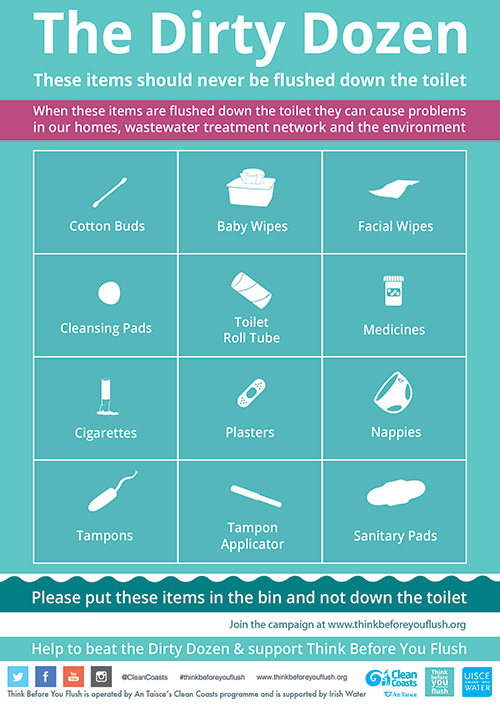Wait ... Don't Flush!
"[Many manufacturers of wipes claim they're] flushable [but most contain rayon or viscose]."
"Unfortunately, the natural water bodies these get into do not have the heat or micro-organism levels to effectively degrade these. That is why we see rayon accumulating in the oceans."
"[Dental floss?] It seems like, 'oh, it's just a little string', but it tends to wrap things up. It'll collect other things and make kind of a big wad of stuff. It's incredibly strong."
Rob Billee, executive director, Plainfield Area Regional Sewerage Authority, Middlesex, New Jersey
 |
To most people it's almost automatic. Just get rid of it. Garbage pail or toilet... Well, isn't the toilet kind of a garbage pail? Um, not exactly. It's meant to flush away urine and excrement and toilet paper that is designed to be flushable. The sewage system of any municipality is just that, a system meant to receive the human waste that we flush away and very little else. Sometimes we look at objects so tiny it seems absurd they could ever become a problem, but depending on what they're made of and the similar thoughts of countless others all flushing those tiny objects they stand a good chance of becoming a sewage headache.
So, if in doubt, forbear. Go directly to the garbage pail and deposit it there. Where it belongs and won't become a problem. Dental floss threads in the toilet or contact lenses seem harmless and they are, disposed of properly. Proper disposal of both is never, ever down the toilet. They'll flush away all right, but they'll also end up becoming a nuisance and more than that. Think of the frequency of use of both dental floss and contact lenses and their casual disposal in the population. Sheer weight of numbers ensures that those tiny, thin contact lenses will end up floating en masse as a durable plastic mess somewhere in the ocean.

In fact those small fragments representing plastic contact lenses are being identified as a contributor to the growing situation of microplastic pollution. And then there are pharmaceuticals and their disposal. They represent items we want to rid ourselves of once they've served their purpose. But the chemicals in those pharmaceuticals, flushed down a drain or the toilet find their way into drinking water. What the final results will be of pharmaceuticals swishing around, however diluted, in our water systems is a big unknown but the potential is not reassuring.
Billions of dollars in maintenance and repair costs is associated with the flushing of larger consumer products such as wipes and tampons which clog sewer systems.

So then there are items of everyday use that appear innocent of any potential problem should they be flushed. Should they be flushed? If we're discussing facial tissues and paper towels, think again. They may resemble toilet paper but they are distinctly unlike paper meant for wiping bottoms and flushing down the toilet. Facial issues are treated with a chemical binder, it's why they don't fall apart when you flush mucous out of your nostrils. But the binder needs time to release and break apart when it's flushed, so it doesn't fare well in the sewer system at all.
Waste water treatment plants do a fairly good job at what they're designed to do, but they're not designed to filter out pharmaceuticals. It's guaranteed; dump your pharmaceuticals in the toilet or the sink drain and they'll end up entering streams, rivers and lakes. The U.S. Geological Survey discovered the presence of low levels of organic waste water compounds inclusive of prescription and non-prescription drugs and hormones in 139 streams across the United States between 1999 and 2000.
In 80 percent of the streams sampled one or more chemicals traced to pharmaceuticals were identified. Some pharmaceuticals persist in spite of water treatment processes, a more recent study concluded after sampling water from 25 drinking-water treatment plants in the United States. As for those contact lenses failing to biodegrade readily; they're impervious to the bacteria that break down biological waste at treatment plants. When contact lenses were submerged in chambers with the bacteria the lenses were intact seven days later.
 |
| The only things to flush down the toilet are pee, poop and toilet paper, thank you very much. Metro Vancouver |
Labels: Cost to Municipalities, Flush, Plumbing, Sewers, Toilets, Treatment

0 Comments:
Post a Comment
<< Home